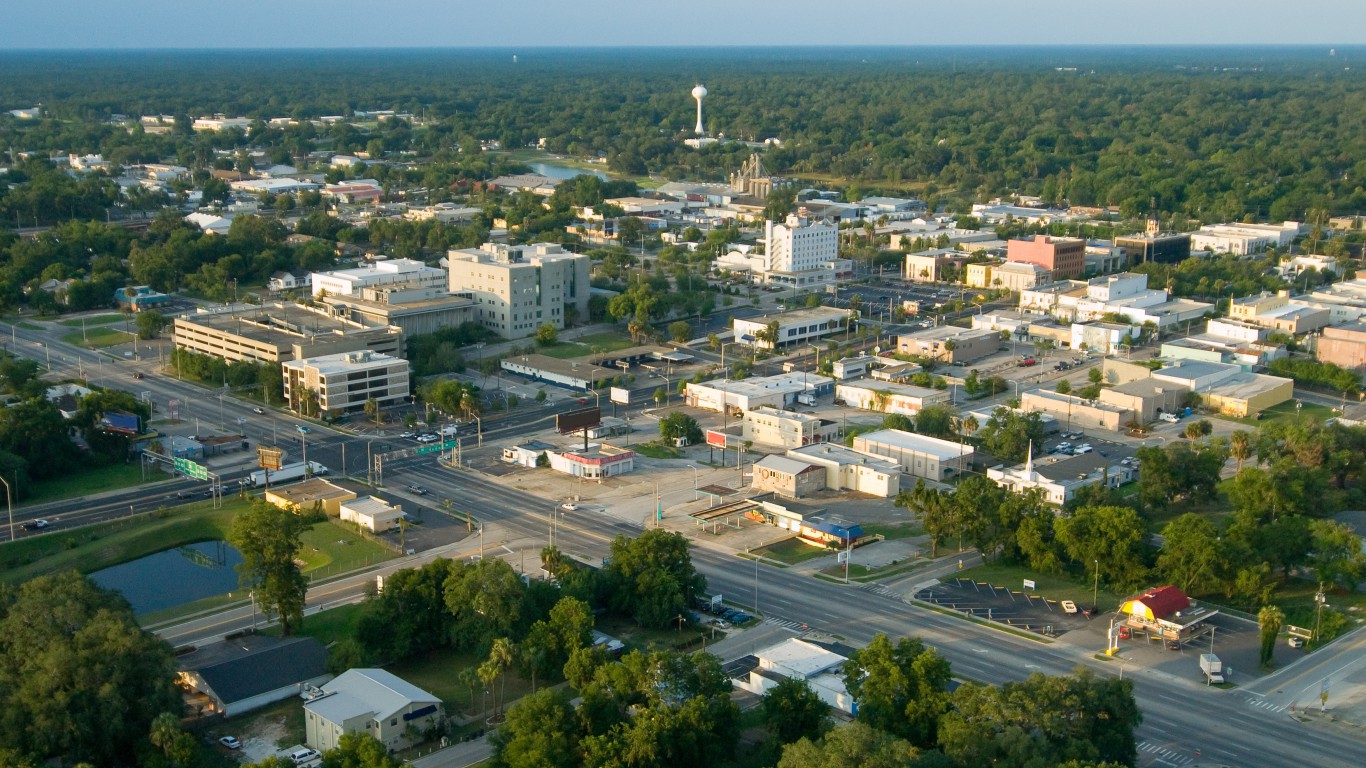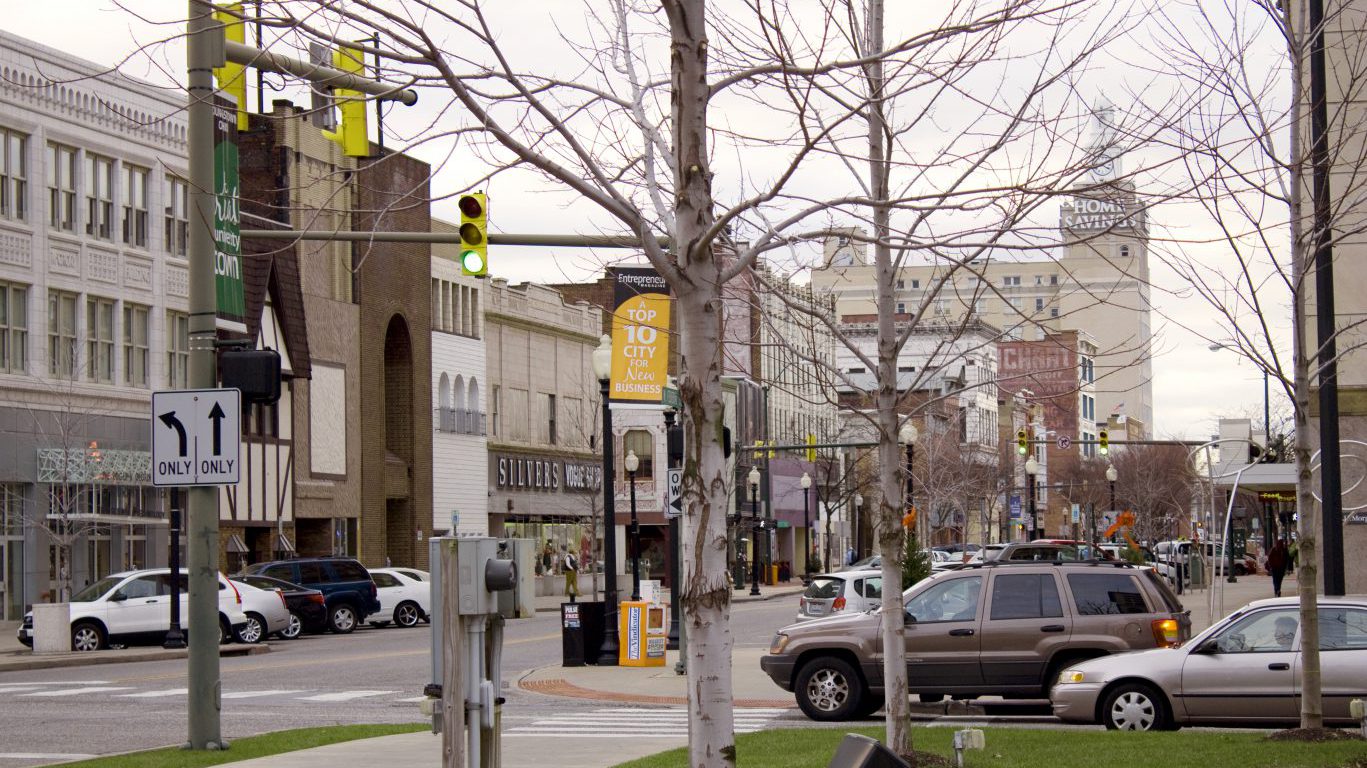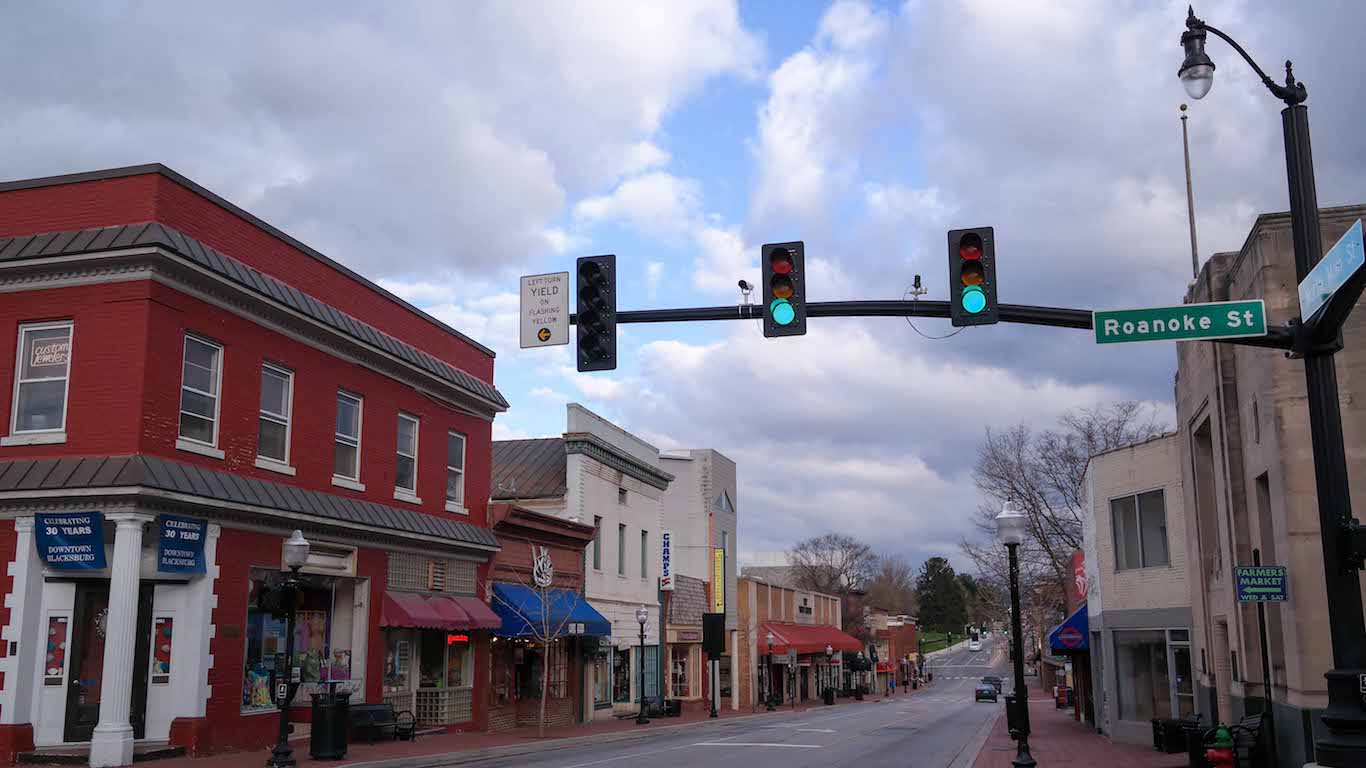Special Report
Cities Where It's Easiest to Get Away With Murder

Published:
Last Updated:

America’s police departments closed the book on 61.5% of all reported homicides in 2015. Police devote more time and resources to violent crime, and the clearance rate for homicide is the highest of any offense.
There is a large discrepancy in the rate of solved murders across U.S. cities. While more than 90% of murders are solved in 36 cities, in some parts of the country more murders go unsolved than solved. In 22 cities, the homicide clearance rate is below 40%.
To determine the cities where it is easiest to get away with murder, 24/7 Wall St. reviewed clearance rates by metropolitan area for the period of 2005 through 2015 based on data from the Federal Bureau of Investigation’s Uniform Crime Report.
Click here to see the cities where it’s easiest to get away with murder.
Click here to see the detailed findings and methodology.

22. Sioux City, IA-NE-SD
> Homicide clearance rate: 39.5%
> No. of murders reported from 2005-2015: 38
> Violent crimes per 100,000 in 2015: 269.5
> Population: 165,491
[in-text-ad]

21. Battle Creek, MI
> Homicide clearance rate: 39.3%
> No. of murders reported from 2005-2015: 84
> Violent crimes per 100,000 in 2015: 559.3
> Population: 134,314

20. Ocala, FL
> Homicide clearance rate: 38.1%
> No. of murders reported from 2005-2015: 168
> Violent crimes per 100,000 in 2015: 363.1
> Population: 343,254

19. New Orleans-Metairie, LA
> Homicide clearance rate: 37.3%
> No. of murders reported from 2005-2015: 2,698
> Violent crimes per 100,000 in 2015: 534.4
> Population: 1.3 million
[in-text-ad-2]

18. Youngstown-Warren-Boardman, OH-PA
> Homicide clearance rate: 37.2%
> No. of murders reported from 2005-2015: 384
> Violent crimes per 100,000 in 2015: N/A
> Population: 549,885

17. Blacksburg-Christiansburg-Radford, VA
> Homicide clearance rate: 37.2%
> No. of murders reported from 2005-2015: 78
> Violent crimes per 100,000 in 2015: N/A
> Population: 179,904
[in-text-ad]

16. Yuma, AZ
> Homicide clearance rate: 36.6%
> No. of murders reported from 2005-2015: 101
> Violent crimes per 100,000 in 2015: 327.4
> Population: 204,275

15. Salinas, CA
> Homicide clearance rate: 36.4%
> No. of murders reported from 2005-2015: 409
> Violent crimes per 100,000 in 2015: 443.2
> Population: 433,898

14. Jackson, MI
> Homicide clearance rate: 35.6%
> No. of murders reported from 2005-2015: 73
> Violent crimes per 100,000 in 2015: 468.4
> Population: 159,494
[in-text-ad-2]

13. Monroe, MI
> Homicide clearance rate: 34.4%
> No. of murders reported from 2005-2015: 32
> Violent crimes per 100,000 in 2015: 236.3
> Population: 149,568

12. Farmington, NM
> Homicide clearance rate: 33.8%
> No. of murders reported from 2005-2015: 65
> Violent crimes per 100,000 in 2015: 443.0
> Population: 118,737
[in-text-ad]

11. Birmingham-Hoover, AL
> Homicide clearance rate: 33.7%
> No. of murders reported from 2005-2015: 1,140
> Violent crimes per 100,000 in 2015: 682.0
> Population: 1.1 million

10. Topeka, KS
> Homicide clearance rate: 32.7%
> No. of murders reported from 2005-2015: 150
> Violent crimes per 100,000 in 2015: 391.7
> Population: 233,791

9. Detroit-Warren-Dearborn, MI
> Homicide clearance rate: 31.8%
> No. of murders reported from 2005-2015: 4,744
> Violent crimes per 100,000 in 2015: 498.1
> Population: 4.3 million
[in-text-ad-2]

8. New York-Newark-Jersey City, NY-NJ-PA
> Homicide clearance rate: 31.0%
> No. of murders reported from 2005-2015: 9,007
> Violent crimes per 100,000 in 2015: N/A
> Population: 20.2 million

7. Grand Rapids-Wyoming, MI
> Homicide clearance rate: 30.9%
> No. of murders reported from 2005-2015: 236
> Violent crimes per 100,000 in 2015: 329.0
> Population: 1.0 million
[in-text-ad]

6. Kokomo, IN
> Homicide clearance rate: 30.0%
> No. of murders reported from 2005-2015: 40
> Violent crimes per 100,000 in 2015: 579.7
> Population: 82,556

5. Lima, OH
> Homicide clearance rate: 24.5%
> No. of murders reported from 2005-2015: 49
> Violent crimes per 100,000 in 2015: 388.5
> Population: 104,425

4. Saginaw, MI
> Homicide clearance rate: 23.3%
> No. of murders reported from 2005-2015: 210
> Violent crimes per 100,000 in 2015: 604.5
> Population: 193,307
[in-text-ad-2]

3. Midland, MI
> Homicide clearance rate: 23.1%
> No. of murders reported from 2005-2015: 13
> Violent crimes per 100,000 in 2015: 143.9
> Population: 83,632

2. Urban Honolulu, HI
> Homicide clearance rate: 18.8%
> No. of murders reported from 2005-2015: 154
> Violent crimes per 100,000 in 2015: 243.9
> Population: 998,714
[in-text-ad]

1. Flint, MI
> Homicide clearance rate: 17.5%
> No. of murders reported from 2005-2015: 577
> Violent crimes per 100,000 in 2015: 581.4
> Population: 410,849
Detailed Findings & Methodology
While the national murder rate has fallen drastically from 9.6 homicides per 100,000 Americans in 1975 to just 4.9 murders per 100,000 today, the clearance rate has declined substantially over the same period, from 77.9% to 61.5%.
One reason for the decline in both the homicide and clearance rates is the changing nature of homicides. Four decades ago, a larger share of homicides were so-called crimes of passion, in which motive is relatively clear and the crime more easily solved. Today, homicides involving gangs and organized crime, which are often more difficult to solve, comprise a larger share of all homicides. In an interview with 24/7 Wall St., Dr. David Carter, professor of criminal justice at Michigan State University, explained, “You’ll tend to see lower clearance rates when a lot of the homicides are gang related, because you can’t get information out of the gang.”
Areas where more crime goes unsolved tend to have more crime overall. Of the 19 cities on this list with available data, 12 have violent crime rates higher than the national rate of 373 annual incidents per 100,000 Americans. Similarly, cities with less violent crime tend to have higher clearance rates. According to Carter, the concurrence of low crime and high clearance rates is a testament to the quality of the police agencies in those areas. “If you’re effective in clearing homicides, you can also prevent them.”
While there are numerous factors that affect clearance rates, according to some law enforcement officials, one of the largest impediments to crime solving is a lack of resources. The chance of solving a homicide is drastically reduced if a prime suspect has not been identified within 72 hours of when the crime is initially reported, and police departments do not always have the resources to employ detectives and other personnel for the overtime required for a homicide investigation. Many of the departments with the lowest clearance rates are in cities with low median household income and a relatively poor tax base.
While police department funding may play a large role in crime solving, one of the most essential resources in crime solving is the relationship between police and the local community. As Carter told us, “The importance of community-based policing is significant when it comes to the ability to solve homicides, simply because of the willingness of people to speak with police.” A study conducted by the Department of Justice found that police departments with the highest clearance rates communicate effectively with locals.
To determine the cities where it is easiest to get away with murder, 24/7 Wall St. reviewed clearance rates by metropolitan area for the period of 2005 through 2015 from the Federal Bureau of Investigation’s Uniform Crime Report master files. Due to inconsistent reporting practices by police agencies, metro areas in Illinois were excluded. Additionally, we excluded data from police jurisdictions for which a county could not be identified, such as Indian reservations, airports, highway patrols, and, in some cases, state police forces. If a police agency spanned multiple counties, data for that agency was assigned to the county with the largest population served by the agency. Data on murders and clearances were aggregated from the police agency level to the county level, and then to the metropolitan statistical area (MSA) level. Because the data were not adjusted for agency size, the metropolitan level estimates may not accurately reflect the individual clearance rates for the police agencies within the MSA borders.
After two decades of reviewing financial products I haven’t seen anything like this. Credit card companies are at war, handing out free rewards and benefits to win the best customers.
A good cash back card can be worth thousands of dollars a year in free money, not to mention other perks like travel, insurance, and access to fancy lounges.
Our top pick today pays up to 5% cash back, a $200 bonus on top, and $0 annual fee. Click here to apply before they stop offering rewards this generous.
Flywheel Publishing has partnered with CardRatings for our coverage of credit card products. Flywheel Publishing and CardRatings may receive a commission from card issuers.
Thank you for reading! Have some feedback for us?
Contact the 24/7 Wall St. editorial team.